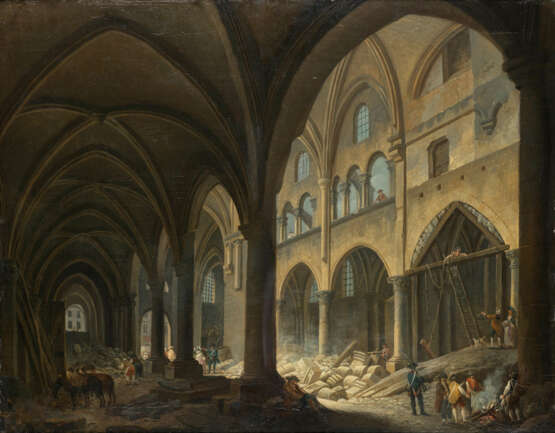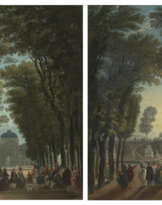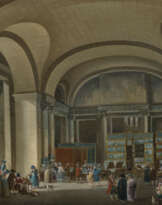ID 974646
Lot 39 | PIERRE-ANTOINE DEMACHY (PARIS 1723-1807)
Estimate value
€ 40 000 – 60 000
Démolition de l'église des Saints-Innocents, Paris
porte une trace de signature et de date (en bas, à gauche)
huile sur panneau
50 x 63,7 cm. (19 2/3 x 25 in.)
Provenance
Collection Cailleux, Paris, vers 1989.
Vente anonyme, Christie's, New York, 23 octobre 1998, lot 97.
Literature
M. L. B. ... De B ... de plusieurs Académies, l'auteur de la Gazette Infernale, Lanlaire au salon académique de peinture, Paris, 1787, pp. 16-17.
A. R., L'ami des artistes au sallon, Paris, 1787, p. 25.
Anonyme, Tarare au sallon de peinture, Paris, 1787, p. 12.
Anonyme, Inscriptions pour mettre au bas de différens tableaux exposés au sallon du Louvre en 1787, Londres, 1787, p. 8.
Exhibited
Paris, Salon, 1787, n°27.
Biron, château de Biron ; Nancy, musée des beaux-arts, La vie en France autour de 1789. Image et représentation 1785-1795, 24 juin-1er septembre 1989 ; 15 septembre-15 novembre 1989, n°3.
Special notice
This lot is offered without reserve.
These lots have been imported from outside the EU for sale and placed under the Temporary Admission regime.
Import VAT is payable at 5,5% on the hammer price. VAT at 20% will be added to the buyer’s premium but will not be shown separately
on our invoice.
Post lot text
PIERRE-ANTOINE DEMACHY, DEMOLITION OF THE SAINTS-INNOCENTS CHURCH, PARIS, INDISTINCTLY SIGNED AND DATED, OIL ON PANEL
Though the destruction of many religious buildings was the consequence of the Revolution, the disappearance of a certain number of churches from the medieval period can be attributed to the ancien régime. Several Parisian churches were sacrificed to the aesthetic mores of Classicism; the Church of the Saints-Innocents in the rue Saint-Denis, which was destroyed at the end of the 18th century along with the adjacent cemetery, belongs to this group.
Originally, the church of the Saints-Innocents was a chapel dedicated to Saint Michael, it was renamed by Louis VI (1081-1137) and enlarged under Philippe Auguste (1165-1223). Its demolition in 1787 came one year after that of the Cimetière des Saints-Innocents. The history of the chapel is not well known: there is no information on the date and circumstances of its foundation, nor on the stages of its construction. We only know that the small chapel in the cemetery was enlarged in 1130 and that the creation of the small parish of Saints-Innocents was one of the results of the dismemberment of the parish of Saint-Germain-l'Auxerrois.
The circumstances of its distruction are much better known. The church was bordered by the cemetery of the Saints-Innocents at the north-east corner, and separated from the rue aux Fers by a row of six houses and a fountain. The cemetery, located in the heart of Paris, was overcrowded with burials and had become dangerous for the neighbouring inhabitants. On 21 May 1765, a parliamentary ruling prohibited burials in all cemeteries located within Paris. The prospect of the land being freed up soon gave rise to plans to renovate and expand a nearby market; at first these only took into consideration the cemetery, the decision was taken to get rid of this and to use its site for a herb and vegetable market. However, very soon the high value of the land in this populous district led to the the developers coverting the land on which the church itself stood.
After lengthy discussions between the public authorities, the clergy and the building committee of the Saints-Innocents over the course of 1786, the abolishment of the parish of the Saints-Innocents and the destruction of the church were agreed upon. Both financial interest and the fashion of the day, which condemned a "building deficient in construction and irregular in form", coupled with the dilapidated state of the structure led to the decision to demolish it. The demolition order was passed on 1 July 1786, on 31 November 1786 the archbishop of Paris abolished the curacy of the Saints-Innocents, and in the course of 1787 the church was razed to the ground.
The Demolition of the Saint Innocents Church is an example of the Demachy's tendency to reproduce the same subject. The present painting was exhibited at the Salon of 1787 (n°27) together with the two works now in the musée Carnavalet (Paris, inv. nos. P 80 and P 2080). The scene allows us to understand the architecture of the lost monument. The artist, who witnessed the metamorphosis of the city at the end of the 18th century, became its historiographer and was appreciated as such by lovers of the city's history.
We would like to thank Ms. Petkowska Le Roux for writing the above note.
| Artist: | Pierre-Antoine Demachy (1723 - 1807) |
|---|---|
| Applied technique: | Oil on panel |
| Art style: | Old Masters |
| Place of origin: | Western Europe, France, Europe |
| Auction house category: | Paintings |
| Artist: | Pierre-Antoine Demachy (1723 - 1807) |
|---|---|
| Applied technique: | Oil on panel |
| Art style: | Old Masters |
| Place of origin: | Western Europe, France, Europe |
| Auction house category: | Paintings |
| Address of auction |
CHRISTIE'S 9 Avenue Matignon 75008 Paris France | ||||||||||||||
|---|---|---|---|---|---|---|---|---|---|---|---|---|---|---|---|
| Preview |
| ||||||||||||||
| Phone | +33 (0)1 40 76 85 85 | ||||||||||||||
| Fax | +33 (0)1 40 76 85 86 | ||||||||||||||
| Conditions of purchase | Conditions of purchase | ||||||||||||||
| Shipping |
Postal service Courier service pickup by yourself | ||||||||||||||
| Payment methods |
Wire Transfer | ||||||||||||||
| Business hours | Business hours
|







